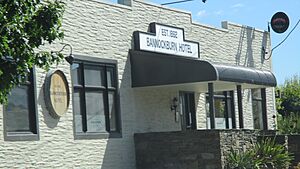Bannockburn, New Zealand facts for kids
Quick facts for kids
Bannockburn
|
|
|---|---|
|
Town
|
|

Bannockburn Hotel
|
|
| Country | New Zealand |
| Region | Otago |
| Territorial authority | Central Otago District |
| Ward | Cromwell Ward |
| Community | Cromwell Community |
| Electorates |
|
| Area | |
| • Total | 16.91 km2 (6.53 sq mi) |
| Population
(June 2023)
|
|
| • Total | 650 |
| • Density | 38.44/km2 (99.6/sq mi) |
| Time zone | UTC+12 (NZST) |
| • Summer (DST) | UTC+13 (NZDT) |
| Local iwi | Ngāi Tahu |
Bannockburn is a small, old gold mining town in Central Otago, New Zealand. It's located near Cromwell.
Back in the 1860s, people found a lot of gold here, especially in the riverbeds. This made Bannockburn a very busy place for miners.
The town has a special warm and dry climate. Because of this, it was once called 'The heart of the desert'. This weather, along with human activity, changed the land a lot, leaving behind rocks and sandy soil. Today, this unique climate is perfect for growing grapes for wine and delicious stone fruits like peaches and apricots.
A Brief History of Bannockburn
How Bannockburn Began
Plans for Bannockburn started in 1862. Miners had to move upstream because water levels in the Clutha and Kawarau Rivers were rising. Even though people settled here around this time, they didn't stay in one spot for long.
The Gold Rush and Changing Landscapes
Miners followed the gold up the creeks, and their settlements moved with them. By 1868, the original town stretched along what is now the Bannockburn-Nevis road. From 1862 to 1871, the land changed a lot. Miners used a method called sluicing to wash away the flat ground to find gold. This created the rugged landscape you see today.
The Importance of Water
During the gold rush, water was very important. It was needed not just for mining but also to supply the town. You can still see signs of the old water system around the area. Many dams, which were actually reservoirs, fed a water system. This system stretched from the Carrick Range down to the old sluicing sites. Tippet's Dam was one of the biggest reservoirs.
Today, this water is used for growing fruit and grapes. The old sluicing sites are now quiet and belong to the Department of Conservation.
Bannockburn's Population
How Many People Live Here?
Bannockburn is considered a rural settlement by Statistics New Zealand. It covers about 16.91 square kilometers. In 2018, about 477 people lived here. This means there were about 28 people living in each square kilometer. Bannockburn is part of a larger area called the Lindis-Nevis Valleys.
| Historical population | ||
|---|---|---|
| Year | Pop. | ±% p.a. |
| 2006 | 315 | — |
| 2013 | 378 | +2.64% |
| 2018 | 477 | +4.76% |
Population Growth Over Time
The number of people living in Bannockburn has grown quite a bit. In 2018, the population was 477. This was an increase of 99 people since 2013, and 162 people since 2006.
In 2018, there were 183 households in Bannockburn. There were slightly more males (246) than females (234). About 57 people were under 15 years old. Most people were between 30 and 64 years old (240 people).
Wine and Tourism in Bannockburn
Why is Bannockburn Great for Wine?
Bannockburn is famous for its wine, especially a type called Pinot noir. This grape grows well here because of the dry climate and special soil. Bannockburn has some of the highest temperatures and lowest rainfall in the Central Otago wine region.
Unique and High-Quality Wines
Because of the area's geography, Bannockburn's vineyards are usually small. They focus on making high-quality, special wines rather than large amounts. Many vineyards here are known around the world. They send their wines to different countries.
Famous Local Wineries
Some of the well-known wineries in Bannockburn include Akarua, Bannock Brae, Felton Road, Mt. Difficulty, and Terra Sancta. These places help make Bannockburn a popular spot for people who love wine and want to explore the beautiful Central Otago region.



